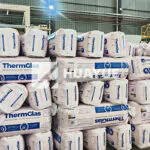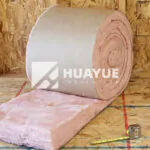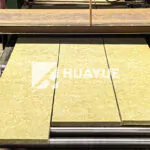Understanding Rockwool: A Comprehensive Guide to Stone Wool Insulation
In the world of building materials, insulation plays a critical role in energy efficiency, comfort, and safety. Among the various options available, Rockwool (also known as stone wool or mineral wool) stands out as a versatile and high-performance material. But what exactly is it, and why should you consider it for your next project? This guide delves into the essential knowledge surrounding Rockwool products.
What is Rockwool?
Rockwool insulation is fundamentally different from fibreglass or foam insulation. It’s manufactured from natural, volcanic rock – typically basalt – and recycled industrial slag. The process mimics the natural formation of volcanic fibres, like those found near active volcanoes (sometimes called “Pele’s hair”).
The Manufacturing Process:
- Melting: Raw materials (rock and slag) are melted in a furnace at extremely high temperatures (around 1500°C or 2730°F).
- Spinning: The molten lava-like substance is then spun at high speed, similar to making cotton candy, drawing it out into fine fibres.
- Binding: A small amount of binder is added, along with mineral oil to suppress dust.
- Collection & Curing: The fibres are collected on a conveyor belt, layered, compressed to the desired density, and then cured in an oven.
- Cutting: Finally, the cured wool is cut into various product forms, such as batts, boards, pipe sections, or loose-fill insulation.
The result is a fibrous material that traps air effectively, giving it excellent insulating properties, but with a unique set of characteristics derived from its stone-based origin.
Key Properties and Benefits of Rockwool
Rockwool’s unique composition translates into a range of compelling benefits:
1. Superior Thermal Performance: Like most insulation, Rockwool works by trapping air within its dense fibre structure. This significantly slows down heat transfer, keeping buildings warmer in winter and cooler in summer. It generally offers a good R-value (a measure of thermal resistance) per inch, comparable or sometimes slightly better than fibreglass, and importantly, its performance is very stable over time and across a range of temperatures. This translates directly into reduced energy consumption for heating and cooling, leading to lower utility bills and a smaller carbon footprint.
2. Exceptional Fire Resistance: This is one of Rockwool’s most significant advantages. Being made from rock, it is inherently non-combustible and can withstand temperatures exceeding 1000°C (1800°F) without melting or producing significant toxic smoke.
- Non-Combustible: It does not contribute fuel to a fire.
- Fire Barrier: It can act as a fire barrier, slowing the spread of flames and providing valuable extra time for occupants to escape and for emergency services to respond.
- Safety: This property significantly enhances building safety, making it a preferred choice for fire-rated walls, ceilings, and around penetrations.
3. Excellent Acoustic Insulation: The dense, non-directional fibre structure of Rockwool is highly effective at absorbing sound waves and reducing noise transmission.
- Sound Absorption: It dampens airborne sound, reducing reverberation and echo within a room.
- Sound Transmission Reduction: It significantly limits the passage of noise between rooms, floors, or from the outside environment. This makes it ideal for interior walls, floors, home theatres, music studios, offices, and buildings near noisy areas like airports or highways, creating quieter and more comfortable indoor environments.
4. Water Repellency and Vapour Permeability: Rockwool fibres are treated to be water-repellent (hydrophobic). While the material itself does not absorb liquid water, it is highly vapour-permeable.
- Moisture Resistance: It resists moisture saturation, which helps prevent sagging and loss of thermal performance.
- Breathability: It allows water vapour (humidity) to pass through easily. This is crucial for building envelope health, as it lets trapped moisture escape, reducing the risk of condensation, mould, mildew growth, and rot within the building structure.
5. Durability and Dimensional Stability: Made from dimensionally stable stone fibres, Rockwool maintains its shape and thickness over time.
- No Sagging or Slumping: Unlike some other insulation types, it doesn’t slump or settle within wall cavities or attic spaces, ensuring consistent thermal performance throughout the building’s lifespan.
- Long Lifespan: Its inherent durability means it effectively lasts for the life of the building without degrading.
6. Sustainability and Environmental Considerations: Rockwool is often recognized for its sustainable attributes:
- Natural & Recycled Content: It’s made primarily from abundant natural rock and a significant percentage of recycled slag content (an industrial byproduct).
- Energy Savings: Its primary function reduces building energy consumption, contributing significantly to lower greenhouse gas emissions over its lifetime.
- Recyclability: Many Rockwool products can be recycled at the end of their life cycle, often back into new insulation products.
- Inert Material: It does not promote mould growth or provide sustenance for pests.
7. Pest Resistance: Being inorganic, Rockwool does not provide a food source for rodents, insects, or other pests, helping to maintain the integrity of the insulation and the building structure.
Common Applications of Rockwool Products
Thanks to its versatility, Rockwool is used in a wide array of applications across different sectors:
- Residential Construction:
- Exterior Walls (Cavity insulation, continuous exterior insulation boards)
- Interior Walls (Thermal and acoustic insulation between rooms)
- Attics and Lofts (Batts or loose-fill)
- Floors (Between joists, especially above unheated spaces like garages or crawl spaces)
- Basements and Crawl Spaces
- Around noisy areas (laundry rooms, media rooms)
- Commercial Buildings:
- Curtain Walls and Facades
- Roofing Systems (Flat and sloped roofs)
- Partition Walls and Ceilings (Especially for fire resistance and acoustics in offices, schools, hospitals)
- Mechanical Rooms and HVAC Systems
- Industrial Applications:
- High-Temperature Pipe Insulation
- Insulation for Boilers, Ovens, and Industrial Furnaces
- Noise Control in Manufacturing Facilities
- Specialized Uses:
- Horticulture (e.g., Grodan products as a growing medium for hydroponics)
- Acoustic Panels and Baffles
- Marine and Offshore Applications (due to fire resistance)
Considerations When Using Rockwool
While Rockwool offers numerous advantages, there are a few points to keep in mind:
- Installation: While not difficult, installation requires proper personal protective equipment (PPE), including gloves, long sleeves, eye protection, and a dust mask. The fibres can cause temporary skin irritation and should not be inhaled.
- Cost: The initial purchase price of Rockwool can sometimes be higher than basic fibreglass insulation, although its long-term performance, durability, and fire safety benefits often provide excellent value over the building’s lifespan.
- Cutting: Due to its density, cutting Rockwool typically requires a serrated knife (like a bread knife or specialized insulation knife) rather than a utility knife.
Conclusion
Rockwool stone wool insulation is a robust, multi-functional building material derived from natural rock. Its unique combination of excellent thermal performance, outstanding fire resistance, superior acoustic insulation, moisture management capabilities, durability, and sustainable attributes makes it a compelling choice for a vast range of construction and industrial applications. Whether you are building a new home, renovating an existing one, or designing a commercial space, understanding the properties and benefits of Rockwool can help you make informed decisions to create safer, quieter, more comfortable, and energy-efficient environments. Consider Rockwool for your next project where high performance and long-term value are paramount.
You may also be interested in:
Ready to Get Started?
Get in touch with our experts for personalized solutions tailored to your needs.
Get Free QuoteLatest Articles

Glass Wool Fire Rating: How Safe Is Your Insulation?
Dec 25, 2025
Let's Work Together
Ready to take your business to the next level? Get in touch with our team of experts and let's discuss how we can help you achieve your goals.
Get Free Solutions



